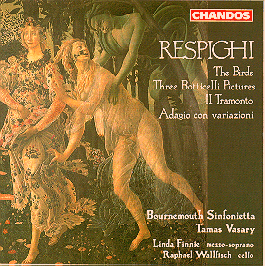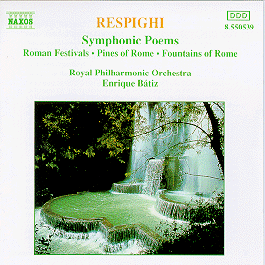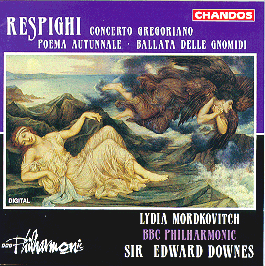Ottorino Respighi pictured here in his thirties.
Photograph and signature facsimile from the private collection
of Adriano and reproduced with permission
Ottorino Respighi: A brief introductory article
by David Heald
Ottorino Respighi was born on 9th July 1879 in Bologna, Italy. A reserved
boy of obvious musical talent, he began studying the violin when he was only
eight. By the age of twenty, he was also a brilliant viola player and a more
than competent pianist, accompanying his wife Elsa in very early recordings
of his own songs and performing as soloist in his own Concerto in modo
misolidio and Toccata - pieces which many of today's pianists
find difficult!
When he was about thirteen, Respighi began studying composition, and in 1900
composed his first major work, still perhaps influenced by the German tradition
- the Symphonic Variations, written for his final school examinations
at the Liceo Musicale.
In the same year, he was playing in the orchestra of the Teatro Comunale,
Bologna, and such was his talent on both violin and viola, that he applied
for, and was offered an engagement with the Imperial Theatre in St.Petersburg
as a viola player. He later also played at the Bolshoi Theatre in Moscow.
Soon fluent in Russian, as he was to be in many other languages, he spent
some five months with Rimsky-Korsakov. The Russian master quickly appreciated
the young Italian's flair and, in the main, looked over Respighi's shoulders,
offering suggestions as appropriate. Nevertheless, Respighi's own brilliantly
colourful scores do owe something to Rimsky-Korsakov. Respighi also attended
lectures by Max Bruch in Berlin.
Back in Bologna, Respighi took his diploma in composition in 1901, and in
the following years consolidated his reputation with a scintillating variety
of works - songs such as Nebbie, his first opera Re Enzo ,
the Prelude, Chorale and Fugue for orchestra, a piano concerto, quintets,
sonatas and the Suite in G Major for Strings and Organ, a sort of
musical homage to Bach, a composer Respighi admired immensely. A brilliant
orchestral arranger, Respighi transcribed not only works by Bach such as
the Three Chorale Preludes and Passacaglia and Fugue, but also
works by compatriots such as Monteverdi, Tartini, Vitali, Vivaldi, and Rossini
(the popular score for the ballet, La Boutique Fantasque is Respighi's
arrangement of music by Rossini). Additionally, Respighi edited many ancient
chamber works for printing and performance and, interestingly, Rachmaninov
, in response to Koussevitzky's suggestion, selected Cinq Études-
Tableaux for Respighi to orchestrate.
 One critic has called Respighi's music 'new old music'. His
profound love of, and identification with the Italian musical past and deliberate
homage to almost forgotten composers from that past, inspired works like
the charming Antiche danze ed arie (Ancient Airs and Dances), the
Concerto in the Antique Style and Gli uccelli (The Birds).
Part pastiche, Respighi stamped his own unique idiom on these works.
One critic has called Respighi's music 'new old music'. His
profound love of, and identification with the Italian musical past and deliberate
homage to almost forgotten composers from that past, inspired works like
the charming Antiche danze ed arie (Ancient Airs and Dances), the
Concerto in the Antique Style and Gli uccelli (The Birds).
Part pastiche, Respighi stamped his own unique idiom on these works.
He paid homage in other ways too. Initially introduced to mediaeval Gregorian
plainchant by his wife, Elsa, Respighi brilliantly introduces the Gregorian
mode into his Concerto gregoriano, Vetrate di chiesa (Church Windows)
- adapted from his own Three Preludes on Gregorian Melodies - and
his archaizing Concerto in the Mixolydian Mode for piano and orchestra.
 The
city of Rome (where Respighi became Professor
of Composition at the Accademia di Santa
Cecilia) is immortalized in his three most
famous works, the Roman trilogy:- the Fontane
di Roma (Fountains of Rome), Pini di Roma
(Pines of Rome) and Feste Romane
(Roman Festivals). In the last named
work in particular, Respighi belies his
reputation for being a `traditional' composer,
with spectacular dissonances, raucous effects
and wholly `modern' orchestrations.
The
city of Rome (where Respighi became Professor
of Composition at the Accademia di Santa
Cecilia) is immortalized in his three most
famous works, the Roman trilogy:- the Fontane
di Roma (Fountains of Rome), Pini di Roma
(Pines of Rome) and Feste Romane
(Roman Festivals). In the last named
work in particular, Respighi belies his
reputation for being a `traditional' composer,
with spectacular dissonances, raucous effects
and wholly `modern' orchestrations.

Throughout the 1920s and early 1930s, brilliant works of very different type
and scale poured forth - the melodramatic Ballata delle gnomidi (Ballad
of the Gnomes), the glorious Adagio with Variations for Cello and
Orchestra; and the Trittico Botticelliano (Three Botticelli
Pictures) for chamber orchestra. There were also distinctive operas,
full of brilliant colour and dramatic flair such as his masterpiece La
Fiamma, La campana sommersa, the witty, ironic Belfagor, the delightful
La bella dormente nel bosco (Sleeping Beauty), and the powerful and
concentrated Lucrezia - his last and most original work for the stage.
As Respighi's fame spread, particularly in the Americas, he was championed
by such musical giants as Toscanini, Koussevitsky and Fritz Reiner as well
as Bernardino Molinari, Tullio Serafin and Willem Mengelberg. He became,
perhaps, the most lionized Italian composer of his generation. On his travels,
he met Busoni, Kodály, Richard Strauss, Ravel, Schoenberg Sibelius
and Stravinsky.
Honours were showered on Respighi - in addition to being awarded the Chair
for Composition at the Academy of Santa Cecilia in Rome in 1913, he was elected
to the Academy of Italy in 1932. Respighi died on the 18th April 1936, aged
only 56. In the January of that year, Respighi's doctor had diagnosed
endocarditis lenta viridans, a bacterial infection which in those days was
still incurable. It sapped the composer's strength (he had a strong physique)
but he struggled on courageously for four months. The disease caused distorted
hearing (in fact Respighi was terrified of becoming deaf.) This disease very
likely affected his work on his last opera, Lucrezia, which was completed,
after his death, by his widow Elsa.
Elsa Respighi, Ottorino's widow, was herself a gifted composer. It was Respighi's
songs that first drew the eighteen year old Elsa to him to become his pupil
before their relationship blossomed into a love affair and marriage. Elsa
outlived Ottorino for many years to champion her husband's work unflaggingly
until her death in 1996 aged almost 102.
In the last twenty years, Respighi's reputation, for some
time belittled and patronized, has been radically reassessed. Recordings and
performances of his work now proliferate. The RESPIGHI SOCIETY, founded in
1993, exists and campaigns to defend (where necessary), and consolidate, the
reputation of one of the great composers of the first half of the 20th Century.
Click on the Photos for an enlarged version © Respighi
Archive

